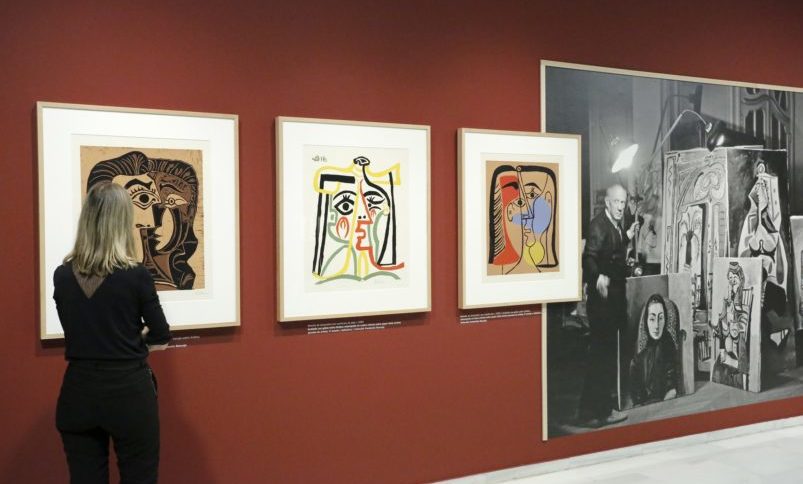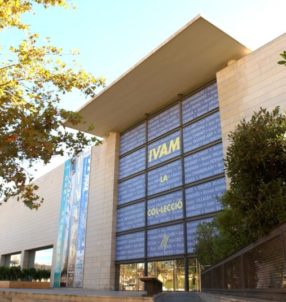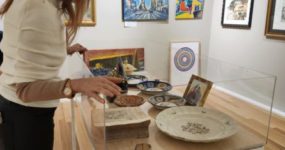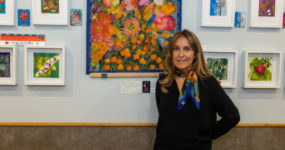The exhibition revisits the theme of the painter and the model in Picasso’s art, focusing on the 20 years of cohabitation with his last wife and muse Jacqueline Roque. Valencia, 19 September 2024. This morning, the Bancaja Foundation presented the exhibition ‘Picasso and the Model. The profile of Jacqueline’, which reviews the constant presence of women as models in Pablo Picasso’s work, focusing on the importance that Jacqueline Roque, his last wife and muse, had in his life and work from the time he met her in 1952 and throughout their cohabitation until the painter’s death in 1973. The presentation was attended by the president of the Bancaja Foundation, Rafael Alcón, and the curators of the exhibition, Fernando Castro and Laura Campos.
The exhibition offers a journey through more than 250 works that reveal Picasso’s recurrent representation of the theme of the painter and the model in oil paintings, graphic works, drawings and illustrated books, showing Picasso’s obsession with meta-painting and the sensual fascination of the encounter with the model.
The works presented come from the collection of Picasso’s graphic work belonging to the Bancaja Foundation, together with oil paintings and drawings from the Museo Nacional Centro de Arte Reina Sofía, the Museo Picasso in Barcelona, the Museo Picasso in Málaga, the Fundación Picasso Museo Casa Natal, ABANCA, the Fundación ICO and Galería Guillermo de Osma.
Along with Picasso’s works, photographs from the archives of Edward Quinn and David Douglas Duncan are on display, showing Picasso in his creative and family environment during the 20 years of the painter’s relationship with Jacqueline, with special emphasis on the residences and workshops they shared in Cannes (La Californie) and Mougins (Notre-Dame-de-Vie).
Women were a constant motif in Picasso’s work, and he was capable of capturing an infinite number of emotions in the women he lived with, producing more than 400 portraits of his muse and second wife during the last two decades of his life. His depictions of women are not limited to a mere reproduction of reality, but are immersed in a profound reflection on identity, sexuality and the status of women in society.
The image of Jacqueline began to take centre stage in Picasso’s imagery from 1954 onwards. The painter carried out frenetic experiments using Jacqueline’s countenance as a pretext, subjecting her profile to extraordinary metamorphoses and repeating the motif in order to achieve singular differences.
Picasso used a variety of optics to depict Jacqueline’s face, resorting to primitivist forms, post-Cubist geometry or playing with classicism. Historical revisions also allow Picasso to represent his wife in his recreations of some of the painters who most influenced him, such as Courbet, El Greco, Velázquez, Rembrandt, Delacroix, Ingres, Manet, Van Gogh and Matisse.
Picasso’s important facet as an engraver is present in the exhibition with works from Suite 347 and Suite 156, together with linocuts and a dozen books illustrated by the artist, including Carnet de la Californie, Le Carmen des Carmen and Les dames de Mougins.
A catalogue has been published on the occasion of the exhibition, with reproductions of the works included in the exhibition and texts by the curators. As part of its cultural and artistic mediation programme, the Bancaja Foundation offers guided tours for the general public and groups.
The exhibition ‘Picasso and the Model. The profile of Jacqueline’ can be visited at the headquarters of the Bancaja Foundation in Valencia (Plaza Tetuán, 23) from 20 September 2024 to 2 March 2025.
MORE INFORMATION
Picasso and Jacqueline, a story and an oeuvre together
The life and work of Pablo Picasso (Malaga, 1881 – Mougins, 1973) were inextricably linked to the women he loved throughout his life: Fernande Olivier, Eva Gouel, Olga Khokhlova, Marie-Térèse Walter, Dora Maar, François Gilot and Jacqueline Roque.
Picasso met Jacqueline Roque (Paris, 1926 – Mougins, 1986) in 1952 in Vallauris, France. This relationship of maturity for Picasso, which the painter began when he was over 70 years old, lasted until his death in 1973. Together with Jacqueline, Picasso rediscovered an impressive vigour for painting and, in particular, produced a number of prodigious etchings.
Jacqueline Roque, whose father was an electrician, was born in Paris on 24 February 1926. Her mother, a seamstress, was forced to work as a concierge in a luxurious building in the 16th arrondissement. When Jacqueline was only two years old, her father abandoned them.
At the age of twenty, Jacqueline married the engineer André Hutin. In 1948, their daughter Cathy was born, with whom Jacqueline would always have a difficult relationship. The family lived for a time in Africa until the marriage broke up. Jacqueline moved to Vallauris and it was there that she met Picasso.
Jacqueline Roque worked in Madoura ceramics (nickname of Suzanne Ramié), a ceramics workshop in Vallauris with which Picasso had been working since 1946. The house-studio at La Californie in Cannes was their first residence and after a brief stay at the Château de Vauvenargues, in 1961 they moved to Notre-Dame-de-Vie, in Mougins, and married on 2 March of that year. Jacqueline remained at Picasso’s side until the artist’s death on 8 April 1973. Jacqueline committed suicide in Notre-Dame-de-Vie on 15 October 1986.
The painter and the model as obsession
At different times Picasso passionately addressed the theme of the painter and his model. The artist avoided using models practically throughout his mature life, preferring to paint people whose lives had affected him and therefore had some real significance for his own. “Of all the themes Picasso tackled, this one of the painter and his model is the one that occupied him the longest, right up to his last works, and there is no other with so many variations and interpretations,” says Pierre Cabanne.
Since the mid-1950s, the omnipresent face in Picasso’s work has been that of Jacqueline, who appears for the first time in the engravings on the plates dedicated to the variations on Les femmes d’Alger by Delacroix in January 1955.
According to Hélène Parmelin, Jacqueline had qualities that made her in Picasso’s eyes “a real woman, a total woman, a warm woman, a woman to laugh and play and also to confront; a woman to live with her nature good and bad, a woman of painting”.
Jacqueline, as some interpreters have pointed out, has in Picasso’s imagination the same role as Saskia had for Rembrandt, “she is the artist’s woman, his obsessive model since the mid-fifties, the profile he loved”, notes Fernando Castro, stressing that “what Picasso modulates with his model is always his desire. In a certain sense, in the obsessive portraits of Jacqueline, Picasso exposes his soul. His wife, full of life, ‘reanimated’ him and inspired him to paint and engrave extraordinary works”.
Picasso the Engraver in the Bancaja Foundation collection
The collection of Picasso’s graphic work belonging to the Bancaja Foundation is one of the most complete and important, comprising the Vollard Suite, consisting of 100 engravings made between 1930 and 1937; Caisse à Remords, made up of 45 prints from 1922 to 1955; Suite 156, comprising 156 prints produced between 1970 and 1972, of which there are only three complete collections, one of them being that of the Bancaja Foundation; Suite 347, with 347 prints produced between March and October 1968; Retratos de familia, comprising five works produced in 1962; Fumadores, 13 prints produced in 1962; and Suite 60, 60 prints from 1966.
Along with these series, the Bancaja Foundation’s collection of Picasso’s graphic works includes 16 linocuts, including those dedicated to Jacqueline and produced in 1963.
A very relevant section in the Picasso collection belonging to the Bancaja Foundation are the 105 books illustrated by Picasso with accompanying illustrations and engravings, totalling 800 in all. These include Le Carmen des Carmen (1964), La Chèvre (1952), Dans L’atelier de Picasso (1957), La tauromaquia o el arte de torear (1959), Température (1960), Les Dames de Mougins (1964) and Notre Dame de Vie (1966).
The qualitative and quantitative relevance of these collections makes the Bancaja Foundation the private institution that owns the largest collection of Picasso’s graphic works internationally, with 2,000 works from galleries such as Louise Leiris, Jean Claude Vrain, Arenthon and Les Argonautes. A valuable artistic heritage that makes the institution an essential reference point for Picasso’s extensive artistic activity in the field of engraving.
Report by ‘24/7 Valencia’ team
Article copyright ‘24/7 Valencia’
Picasso and the model. Jacqueline’s profile
From 20/09/2024 to 02/03/2025
Bancaja Foundation Centre
Plaza de Tetuán, 23 ,Valencia (Valencia)
Opening hours:
Tuesday to Sunday: from 10 am to 2 pm and from 4.30 pm to 8.30 pm.
Closed on Mondays, except for public holidays and the day before public holidays.
Exhibition visiting rules.
Tickets:
General admission: 7 euros.
Reduced: 4 euros (pensioners, unemployed, people with disabilities, students from 13 to 26 years old and large families).
Free (under 12 years old).
Tickets on sale at the box office (Plaza Tetuán, 23).
Each ticket gives access to all the exhibitions on display at the Bancaja Foundation at the time of the visit.
Guided tours
General public
Duration: 50 minutes.
Minimum attendance of 6 people per session for the activity to take place.
Price: 5€ + Exhibition ticket.
Information and bookings: visitascomentadas@fundacionbancaja.es.
Groups:
Duration: 50 minutes.
Sessions: Tuesday: 10 am, 11 am, 12 noon, 5 pm, 6 pm and 7 pm / Wednesday: 10 am, 11 am and 12 noon.
Maximum capacity 25 people.
Information and bookings: visitascomentadas@fundacionbancaja.es.
Related Post
This site uses Akismet to reduce spam. Learn how your comment data is processed.

























Leave a comment